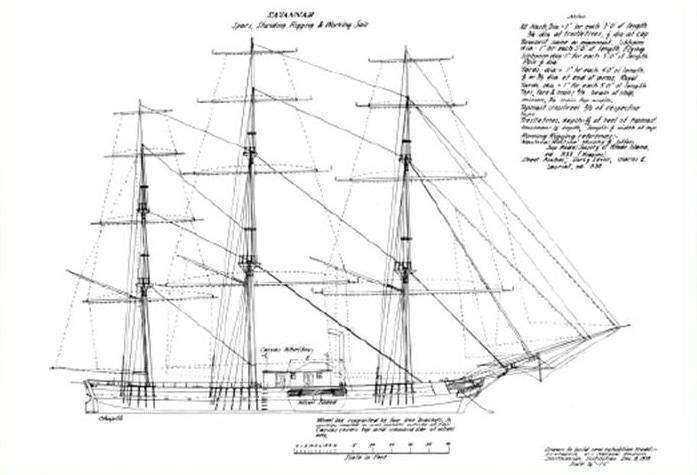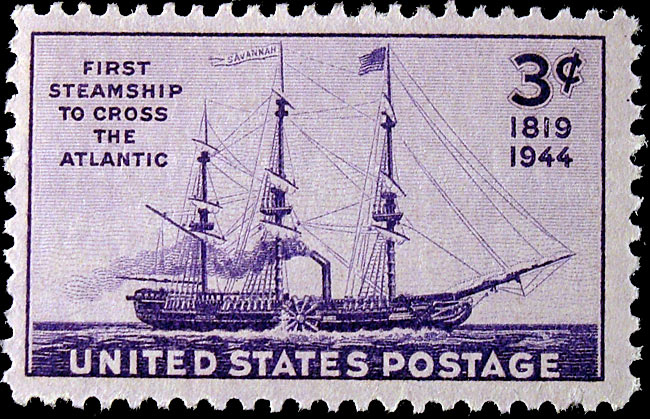|
SS SAVANNAH
This page
is about the steamship Savannah. If you want a model of
the nuclear ship, please click here:
NS Savannah.
SS
Savannah was the first vessel to cross the
Atlantic Ocean partly under steam power. Savannah’s use
of steam power was so advanced for its time and so
important that the May 22 date which the ship first used
its engine in 1819 is commemorated as National
Maritime Day.
SS Savannah proved that a steamship was
capable of crossing the ocean. However, it would be
almost another 20 years before steamships began making
regular crossings of the Atlantic (and the first ships
to do so were British). Another American-owned steamship
would not cross the Atlantic Ocean until 1847.

The 98.5' long SS Savannah
was built in 1818. While she
was being built as a traditional sailing ship by the New
York shipbuilding firm of Fickett & Crockett, Captain
Moses Rogers (with the financial backing of the Savannah
Steam Ship Company), purchased the vessel. He instructed
the shipbuilders to add a
90-horsepower
auxiliary steam engine and sidewheel paddles.
The ship’s wrought-iron paddlewheels were
16 feet in diameter with eight buckets per wheel. To
reduce drag when the engine was not being used, the
paddlewheel buckets were linked by chains instead of
bars, which enabled the wheels to be folded up like fans
and stored on the ship’s deck. In addition, the
paddlewheel guards were made of canvas stretched over a
metal frame; it could also be packed away when not in
use. The process of retracting the wheels and guards
only took about 15 minutes. The SS Savannah is the only
known ship to have been fitted with retractable
paddlewheels.
Because the ship did not have enough
space to carry much fuel, the engine was intended to be
used only in calm weather, when the sails were unable to
provide a speed of at least four knots.
SS Savannah
had 32 passenger berths divided among 16 large and
comfortable staterooms. There were three fully furnished
saloons, furnished with carpets, curtains and hangings,
and decorated with mirrors. The ship’s interior was
described as more closely resembling a pleasure yacht
than a steam packet.
A short “sea-trial” of two hours was
conducted in New York Harbor to test the Savannah’s
engine on March 22, 1819. Less than one week later,
(March 28) the Savannah sailed from New York to her
operating port of Savannah, Georgia. On the morning of
March 29 the ship’s steam-powered engine was started,
but was only used for 30 minutes before being shut down
due to rough weather. The Savannah reached her namesake
port on April 6. The steam engine and paddlewheels were
used for 41.5 hours of the 207-hour voyage.
A few days after the Savannah arrived in
Savannah Harbor from New York, President Monroe visited
nearby Charleston, South Carolina, on an inspection tour
of arsenals, fortifications and public works along the
East Coast. When the Savannah’s principal owner, William
Scarbrough, heard about Monroe’s visit, he instructed
Rogers to sail to Charleston and to invite the President
to visit Savannah aboard the steamship.
On May 11, President Monroe took his
excursion on the ship. The Savannah departed under steam
for Tybee Lighthouse. Monroe dined on board the ship and
expressed his enthusiasm to Scarbrough regarding the
prospect of an American vessel inaugurating the world’s
first trans-Atlantic steamship service. In addition,
impressed by the ship’s machinery, Monroe invited
Scarbrough to sail the ship to Washington after her
trans-Atlantic crossing for an inspection by Congress.
Following President
Monroe’s departure, the Savannah’s crew, with Captain
Moses Rogers in command made final preparations for the
Atlantic crossing. The ship’s owners sought passengers
and freight for the voyage, but no one was willing to
risk lives or property on the novel vessel. This was
several years before steam-powered railroads were
founded, and steam power was considered “too
experimental and dangerous.” Therefore, the ship made
her historic voyage with its crew only.
At 5 a.m. on May 24, 1819,
the Savannah set off for Liverpool, England under both
steam and sail. During the voyage the ship was spotted
by several others with smoke billowing from her stacks
while it outran sailing ships along the route.
The schooner Contract saw
a ship on May 29 “with volumes of smoke issuing,” and
assuming it was on fire, followed it for several hours
but could not catch the Savannah. Contract’s captain
eventually concluded that it must have been a steamboat,
and thought it “a proud monument of Yankee skill and
enterprise.”
Then on June 2, the
Savannah, moving at a speed of about 10 knots, passed
the sailing ship Pluto. After being informed by Captain
Rogers that his ship was functioning “remarkably well,”
the Pluto’s crew gave the Savannah three cheers, as “the
happiest effort of mechanical genius that ever sailed
the western sea.” Savannah’s next recorded encounter
took place off the coast of Ireland on June 19. The
cutter HMS Kite made the same mistake as Contract three
weeks earlier; it chased the steamship for several hours
believing it to be on fire. Unable to catch the
Savannah, Kite fired several shots from its cannons;
causing Captain Rogers to halt the Savannah. The Kite’s
commander then asked permission to inspect the ship. The
British sailors were “much gratified” to satisfy their
curiosity about the Savannah.
By June 18 the ship had
run out of coal and wood for its boilers. The Savannah
was off Cork, Ireland, and sailed to Liverpool on wind
power alone. By June 20, the ship reached Liverpool.
Hundreds of boats sailed out of Liverpool Harbor to meet
the unusual vessel, including a British sloop-of-war.
The ship was greeted by large crowds when it anchored at
6 p.m. The voyage across the Atlantic Ocean had taken 29
days and 11 hours, of which 80 hours were under steam
(about 11% of the total time).
The Savannah stayed in Liverpool for 25
days, during which the crew scraped and repainted the
ship, tested the engine, and replenished fuel and
supplies. During the time it was in Liverpool, the
Savannah was visited by thousands of people, including
officers of the army and navy and other “persons of rank
and influence.” On July 21 the ship departed Liverpool
bound for St. Petersburg, Russia.
The Savannah reached Elsinore (now known
as Helsingor), Denmark, on August 9. Five days later, it
sailed for Stockholm, Sweden. Arriving at Stockholm on
August 22, the Savannah was visited by the Prince of
Sweden and Norway on August 28. The ship was used for an
excursion around local islands on September 1, attended
by the “American and other ambassadors, nobles and
prominent citizens.”
While the Savannah was in port at
Stockholm, the Swedish government sought to purchase the
ship, but Moses Rogers rejected the offer. On September
5, Savannah departed for Kronstadt, Russia, and arrived
there on the 9th.
The Emperor of Russia came aboard the SS
Savannah and presented Captain Rogers with a gold watch
and two iron chairs. From Kronstadt, the ship sailed on
to St. Petersburg, arriving there on September 13.
During the voyage from Liverpool to St. Petersburg, the
Savannah’s engine was used more frequently (a total of
241 hours).
The American ambassador to Russia invited
numerous prominent figures to visit the ship, and on
September 18, 21, and 23, the Savannah made several
steam-powered excursions in the waters near St.
Petersburg. Those on the ship included members of the
Russian royal family and other noblemen, as well as army
and navy officers. As in Sweden, the Russian government
tried to purchase the ship.
On September 27 and 28, the crew of the
Savannah loaded coal and stores for the return journey
to the United States. The ship was plagued by gales and
rough seas for almost its entire westward voyage. The
engine was not used until the Savannah neared the United
States. The crossing took 40 days; the ship steamed up
the Savannah River and arrived safely back at the port
of Savannah at 10 a.m., November 30, six months and
eight days after she had departed.
The Savannah only stayed
at her home port until December 3. As was promised to
President Monroe, she set sail for Washington, D.C.,
arriving there on the 16th. While the ship was docked at
Washington, a major fire swept through the city of
Savannah on January 20, 1820, severely damaging the
business district. William Scarbrough and his partners,
the owners of the Savannah, suffered financial losses in
the fire and were forced to sell the ship.
Savannah’s engine was
removed and sold for $1,600 (about $40,000 today) to the
Allaire Iron Works, which had originally built the
engine’s cylinder. It was preserved by James P. Allaire,
and was later displayed at the New York Crystal Palace
Exhibition of 1856.
After its engine was
removed, the Savannah was used as a sailing packet,
operating between New York and Savannah. However, the
Savannah ran aground along the south shore of Long
Island on November 5, 1821, and subsequently broke
apart.
The Savannah was the
subject of a 3¢ U.S. commemorative stamp that was issued
on May 22, 1944.

We build SS Savannah model the
following sizes.
24" long
$2,990
Shipping and insurance in
the contiguous USA included.
Other places: $300 flat rate.
30" long
$3,790
Shipping and insurance in
the contiguous USA included.
Other places: $400 flat rate.
40" long
$5,600
Shipping and insurance in
the contiguous USA included.
Other places: $500 flat rate.
Model is built per commission only. We require only a
small deposit (not full amount, not even half) for
materials to start
the construction $900. The
remaining balance won't be due until the model is
completed,
in several months.
Learn more about the SS
Savannah here:
https://en.wikipedia.org/wiki/SS_Savannah
|